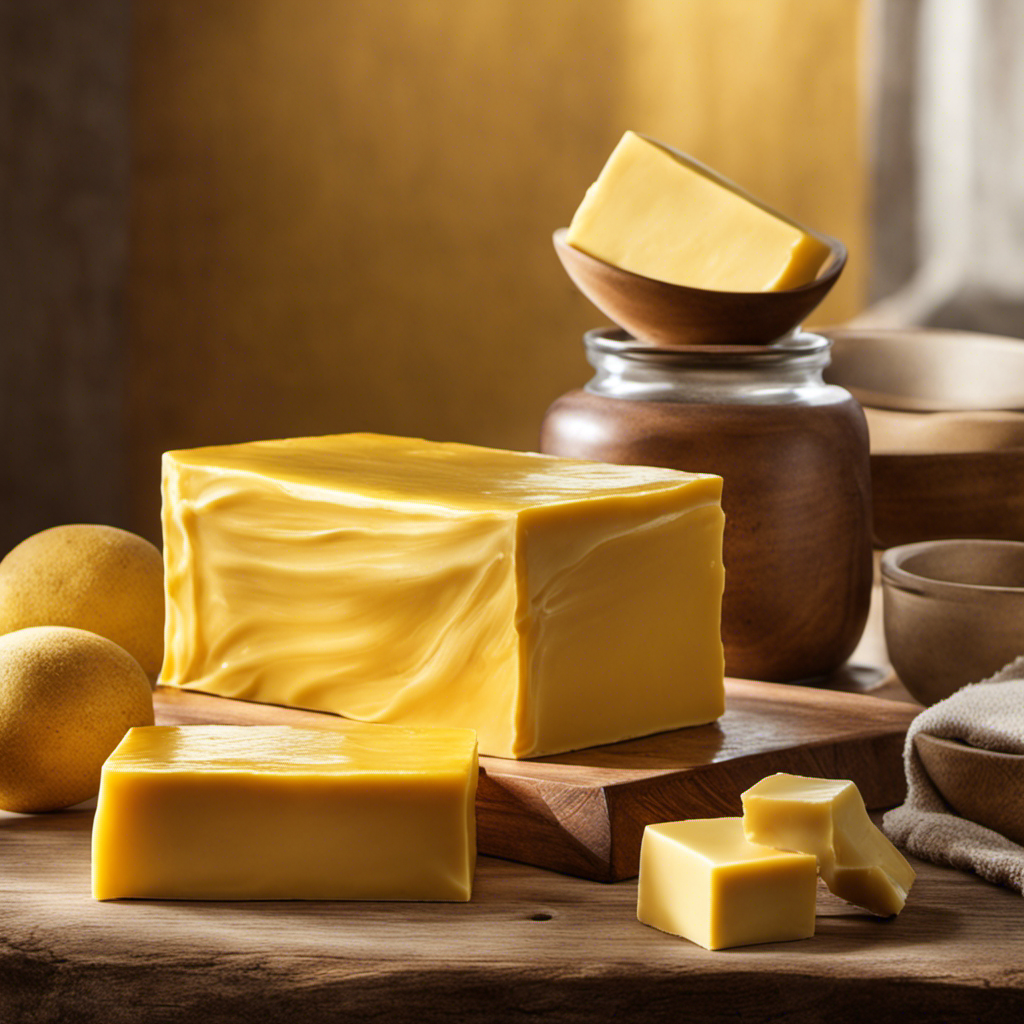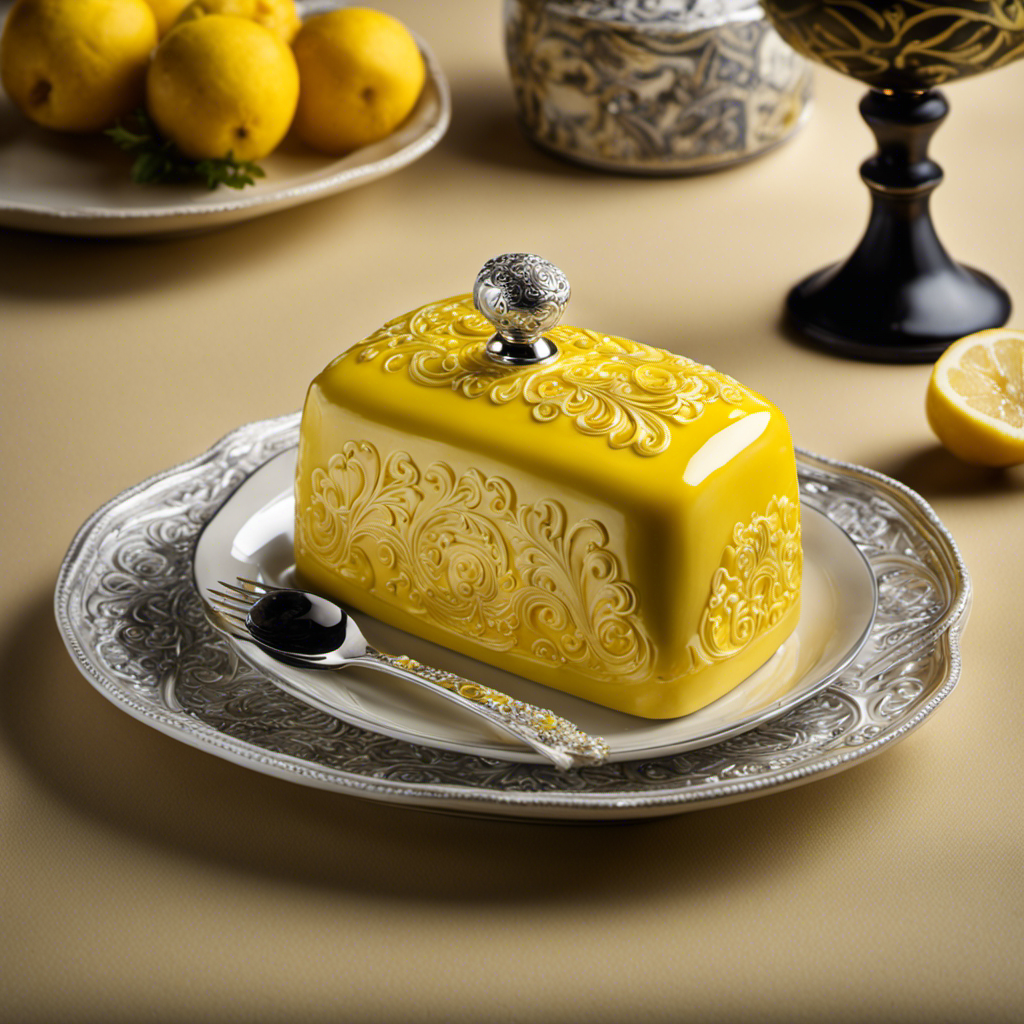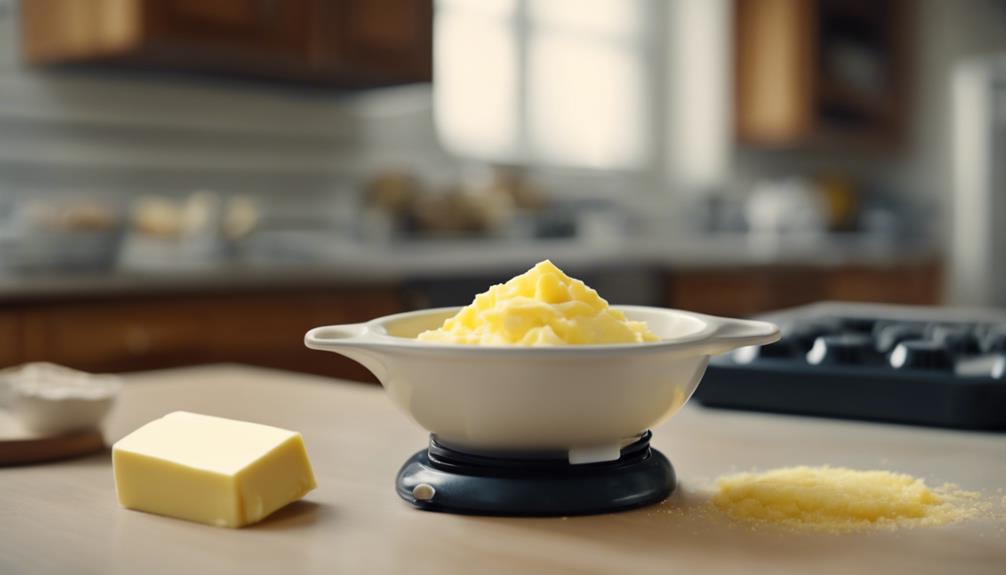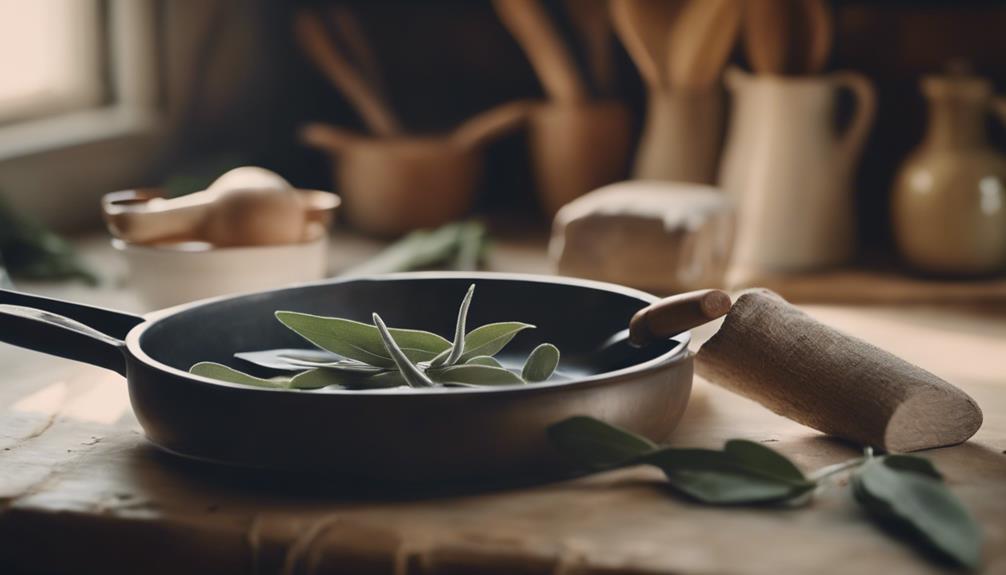Have you ever wondered why butter has the same yellow color as a sunflower field? I’ve got the scoop for you!
In this article, we’ll dive deep into the science behind butter’s vibrant hue. We’ll explore the role of carotenoids in giving butter its yellow color and how a cow’s diet plays a crucial role in this process.
Join me as we uncover the secrets behind butter’s golden glow and discover why it’s not just a pretty color, but a sign of quality too.
Key Takeaways
- Butter gets its yellow color from a natural pigment called beta-carotene.
- Carotenoids, such as beta-carotene, lutein, and zeaxanthin, are responsible for giving butter its distinctive yellow hue.
- A diet rich in carotenoids can reduce the risk of chronic diseases like heart disease and certain types of cancer.
- Factors like sunlight exposure, cow breed, grass type, and extraction techniques can affect the amount and intensity of carotenoids in butter, influencing its final color.
The Science Behind Butter’s Yellow Color
Did you know that butter is yellow because of a natural pigment called beta-carotene? Beta-carotene is a type of carotenoid, a pigment found in fruits, vegetables, and plants. When cows eat grass, they consume carotenoids, which get absorbed into their bloodstream. These carotenoids then travel to the cow’s mammary glands and become part of the milk fat.
During the butter-making process, the milk is churned, causing the fat globules to rupture. This rupture releases the beta-carotene, which undergoes chemical reactions. These reactions lead to the formation of compounds that give butter its distinct yellow color. The amount of beta-carotene in the butter can vary depending on factors like the cow’s diet and breed, resulting in different shades of yellow.
The Role of Carotenoids in Butter’s Hue
When it comes to the yellow color of butter, one key player is carotenoids. Carotenoids are natural pigments that can be found in various fruits, vegetables, and even some animal products.
In butter, carotenoids are responsible for giving it that distinctive yellow hue.
Carotenoids and Yellow Color
Carotenoids are what give butter its yellow color. These natural pigments are found in various fruits and vegetables and are known for their health benefits. Here are five key points about carotenoids and their impact on human health:
- Carotenoids are powerful antioxidants that help protect our cells from damage caused by free radicals.
- Studies have shown that a diet rich in carotenoids can reduce the risk of chronic diseases, such as heart disease and certain types of cancer.
- Carotenoids, such as beta-carotene, lutein, and zeaxanthin, are important for maintaining healthy vision and preventing age-related macular degeneration.
- Including carotenoid-rich foods in our diet, such as carrots, sweet potatoes, spinach, and tomatoes, can help boost our intake of these beneficial compounds.
- Incorporating carotenoid-rich recipes, such as a colorful vegetable stir-fry or a vibrant tomato soup, can not only enhance the taste but also provide us with an array of health benefits.
Butter’s Natural Pigments
The natural pigments found in butter give it a distinct color. One of the main factors that influences the color of butter is sunlight. When cows graze on fresh grass, they consume carotenoids, which are natural pigments found in plants. These carotenoids are then metabolized by the cow’s body and are incorporated into the butterfat. Sunlight exposure can enhance the color of these carotenoids, resulting in a deeper yellow hue in the butter.
Additionally, genetic factors also play a role in determining the color of butter. Certain breeds of cows, such as Jersey and Guernsey, naturally produce milk with a higher concentration of carotenoids, leading to a richer yellow color in the butter.
Influence of Carotenoids
You can enhance the color of butter by exposing it to sunlight. The color of butter is influenced by the presence of carotenoids, which are natural pigments found in plants. These carotenoids can be extracted from certain plants and used to enhance the color of butter.
The influence of climate on the color of butter is significant, as the amount of carotenoids in plants can vary depending on factors such as temperature and sunlight exposure. Additionally, carotenoid extraction techniques play a crucial role in determining the color of butter. Different extraction methods can yield varying amounts of carotenoids, which in turn affect the final color of the butter.
Therefore, both climate and extraction techniques are essential factors to consider when aiming to achieve a desired color for butter.
- Climate: Temperature and sunlight exposure affect the amount of carotenoids in plants.
- Carotenoid Extraction Techniques: Different methods yield varying amounts of carotenoids.
- Butter Color Enhancement: Sunlight exposure can enhance the color of butter.
- Natural Pigments: Carotenoids are natural pigments found in plants.
- Importance of Carotenoids: Carotenoids play a crucial role in determining the color of butter.
How Cows’ Diet Affects Butter’s Color
When it comes to the color of butter, the diet of cows plays a crucial role. One key factor is the type of grass that cows consume. Certain grasses, such as those high in carotenoids, can lead to a richer yellow hue in the butter.
Additionally, the pigments found in the cows’ diet, such as beta-carotene, can be transferred to the milk and ultimately affect the color of the butter.
This connection between cow grass and butter, as well as the pigments in their diet, sheds light on the mystery of why butter is yellow.
Cow Grass and Butter
Why is butter yellow? It’s because cows eat grass. When cows graze on grass, they consume a pigment called carotene found in the plants. This pigment is then stored in their body fat, which includes the milk they produce.
During the butter production process, cream is separated from the milk and churned to separate the fat and water content. The fat in the cream contains the carotene, giving butter its yellow color.
Here are five key points to consider:
- Cows’ diet largely consists of grass, which contains carotene.
- Carotene is a pigment that gives butter its yellow color.
- The carotene is stored in the cow’s body fat, which includes their milk.
- Cream is separated from the milk during the butter production process.
- The fat in the cream contains the carotene, resulting in yellow butter.
Pigments in Cow’s Diet
In my previous discussion about cow grass and butter, I explored how the diet of cows can affect the color of the butter they produce. Now, let’s delve deeper into the pigments in a cow’s diet that contribute to the yellow color of butter.
One of the key compounds responsible for this vibrant hue is carotenoids. Carotenoids are natural pigments found in plants, and when cows consume grass or forage that contains these pigments, they get incorporated into their milk fat. As a result, the butter produced from this milk takes on a yellowish tint.
The presence of carotenoids in a cow’s diet can vary depending on factors such as the season and the type of forage available. Understanding the relationship between diet and butter pigments is crucial in unraveling the yellow butter mystery.
Now, let’s explore the factors that contribute to the enigma of yellow butter.
Yellow Butter Mystery
The mystery behind the yellow hue of butter is still being investigated. While butter is typically pale yellow, the intensity of the color can vary depending on factors such as the cow’s diet and breed. Here are some key aspects to consider when exploring the origin of butter’s yellow color and its historical significance:
-
Genetic variation: Certain cow breeds naturally produce milk with a higher concentration of beta-carotene, a pigment responsible for the yellow color.
-
Diet: Cows that graze on fresh grass or eat hay with high carotene content are more likely to produce yellow butter.
-
Processing methods: The churning process can also influence the color of butter, with longer churning times resulting in a deeper yellow hue.
-
Historical context: Traditional butter-making methods involved using milk from cows grazing on nutrient-rich pastures, which contributed to the yellow color.
-
Consumer preference: Over time, consumers have come to associate the yellow color with higher quality and taste, leading to the popularity of yellow butter.
Understanding the origin and history of yellow butter adds an interesting layer to the ongoing investigation of its yellow hue.
The Impact of Grass-Fed Vs Grain-Fed Diet on Butter’s Hue
When you choose to feed cows grass instead of grain, the butter they produce will likely have a more vibrant yellow hue. This is because grass contains higher levels of carotenoids, which are natural pigments responsible for the yellow color in butter. Carotenoids are fat-soluble compounds that are found in plants, and when cows consume grass, these compounds are absorbed into their bloodstream and ultimately accumulate in their milk fat. Grass-fed cows have been shown to produce butter with higher levels of carotenoids compared to grain-fed cows. This not only gives the butter its distinct yellow color, but it also provides nutritional benefits. Carotenoids are known for their antioxidant properties and have been linked to various health benefits, including improved eye health and reduced risk of chronic diseases.
To further emphasize the impact of grass-fed vs grain-fed diets on the color and nutritional benefits of butter, let’s take a look at the following table:
| Grass-Fed Diet | Grain-Fed Diet |
|---|---|
| Higher levels of carotenoids | Lower levels of carotenoids |
| Vibrant yellow hue | Pale yellow hue |
| Rich in antioxidants | Lower antioxidant content |
| Nutritional benefits | Potential nutritional deficiencies |
As you can see, feeding cows grass results in butter that is not only visually appealing with its vibrant yellow hue, but also offers higher levels of antioxidants and potential nutritional benefits compared to butter produced from grain-fed cows.
The Role of Beta-Carotene in Butter’s Yellow Shade
To achieve that vibrant hue in your butter, it’s important to understand the role beta-carotene plays. Beta-carotene is a carotenoid pigment found in plants that can be converted into Vitamin A by our bodies. In the case of butter, the yellow color is a result of the cow’s diet and the carotenoids present in the grass they consume.
Here are some key points to consider about carotenoid synthesis and butter color genetics:
- Carotenoids are synthesized by plants through a process called carotenogenesis.
- The intensity of the yellow color in butter depends on the amount of beta-carotene present.
- Certain breeds of cows have a genetic predisposition to produce more yellow pigment in their milk.
- Grass-fed cows have a higher intake of carotenoids, resulting in a deeper yellow color in their butter.
- Butter made from grain-fed cows may be paler in color due to the lower carotenoid content in their diet.
Understanding the role of beta-carotene and the impact of diet on butter color genetics can help you achieve that desired vibrant shade in your butter.
The Influence of Processing Methods on Butter’s Color
Processing methods can affect the color of butter, with certain techniques resulting in a more vibrant hue. One such method is carotenoid extraction, commonly used in industrial processing. Carotenoids are natural pigments found in plants and are responsible for the yellow color of butter. During the extraction process, these pigments are separated from the butterfat, resulting in a paler shade.
However, not all processing methods involve carotenoid extraction. Some techniques, such as churning at higher speeds or using cultures with higher carotene content, can enhance the yellow color.
Additionally, the type of cow’s diet can also impact the color of butter. Cows that graze on fresh grass produce milk with higher levels of carotenoids, resulting in a more golden butter.
Factors That Can Alter Butter’s Yellow Pigment
When discussing the factors that can alter butter’s yellow pigment, it’s important to consider the use of natural versus artificial coloring and the diet of dairy cows.
Natural coloring, such as carotenoids found in grass-fed cows, can contribute to the yellow color of butter. On the other hand, artificial coloring may be used to enhance or maintain the desired yellow hue.
Additionally, the diet of dairy cows, whether they’re fed a diet high in carotenoids or not, can also affect the color of the butter they produce.
Natural Versus Artificial Coloring
Why is butter yellow?
Well, you might be wondering about the difference between natural and artificial coloring. Natural coloring is derived from sources such as annatto, marigold flowers, or carrots, while artificial coloring is created in a laboratory.
The use of food dyes in butter can greatly influence its color, which in turn impacts consumer perception. Here are five key points to consider:
- Natural coloring can vary in intensity, resulting in shades of yellow ranging from pale to deep.
- Artificial coloring allows for more control over the desired shade of yellow.
- Some consumers prefer the vibrant color associated with artificial coloring, as it may indicate freshness.
- Others prefer the more subtle hue of naturally colored butter, perceiving it as a sign of a more wholesome product.
- The choice between natural and artificial coloring ultimately depends on personal preference and the desired perception of the butter product.
Diet of Dairy Cows
Dairy cows’ diets greatly impact the nutritional content of their milk. The same holds true for butter production. The feed that cows consume can influence the color, taste, and composition of the milk they produce. Different cow feeds contain varying levels of carotenoids, which are natural pigments responsible for the yellow color in butter. To understand the relationship between cow feed and butter production, let’s take a look at the table below:
| Cow Feed | Carotenoid Content |
|---|---|
| Grass | High |
| Corn | Low |
| Alfalfa | Moderate |
| Silage | Moderate |
| Soybean Meal | Low |
As you can see, cows that consume grass-based diets have higher carotenoid content, resulting in a more yellow-colored butter. This table highlights the importance of cow feed in determining the color and nutritional value of butter. In the next section, we will explore the relationship between butter’s color and its nutritional value.
The Relationship Between Butter’s Color and Nutritional Value
To understand the relationship between the color of butter and its nutritional value, you might want to consider factors like the cow’s diet and the presence of natural pigments. Here are five key points to consider:
-
The yellow color of butter is primarily due to the presence of carotenoids, which are pigments found in plants that cows consume. Carotenoids are a group of antioxidants that have numerous health benefits, including promoting eye health and reducing the risk of certain diseases.
-
The amount of carotenoids in butter can vary depending on the cow’s diet, with cows fed on fresh grass producing butter with higher levels of carotenoids.
-
The cultural significance of butter’s yellow color is evident in various cuisines, where it is often associated with richness, flavor, and quality.
-
While the color of butter does not necessarily indicate its nutritional value, butter with a deeper yellow hue may contain higher levels of carotenoids and potentially offer greater health benefits.
Butter’s Yellow Hue: A Sign of Quality
If you’re looking for a sign of quality in butter, one thing you can consider is the richness and vibrancy of its hue. The significance of butter’s hue goes beyond just aesthetics; it can tell us a lot about the butter’s composition and nutritional value. In fact, the yellow color of butter comes from the natural pigments found in the diet of dairy cows, specifically beta-carotene. This compound is abundant in fresh grass and is converted by the cow’s body into vitamin A. The cultural symbolism of yellow butter also plays a role in our perception of its quality. In many cultures, the color yellow is associated with sunshine, warmth, and richness, which adds to the appeal of yellow butter.
To give you a visual representation, here is a table showcasing the different hues of butter:
| Hue | Description |
|---|---|
| Pale Yellow | Subtle and light |
| Golden | Rich and vibrant |
| Deep Yellow | Intense and full-bodied |
| Amber | Luxurious and indulgent |
Natural Vs Artificial Colorants in Butter: Pros and Cons
Using natural colorants in butter has both advantages and disadvantages.
-
Natural colorants, such as annatto or turmeric, are derived from plants and are generally considered safe for consumption. These colorants can provide a vibrant and appealing yellow color to butter, making it visually appealing to consumers.
-
Consumer preferences for natural colorants in food products have been increasing due to concerns about the potential health risks associated with artificial colorants. Using natural colorants aligns with the growing demand for clean label products that are free from artificial additives.
-
However, the use of natural colorants can be more expensive and less consistent in achieving a desired color compared to artificial colorants.
Overall, while there are ethical concerns surrounding the use of artificial colorants and consumer preferences for natural alternatives, the decision to use natural colorants in butter comes with its own set of advantages and disadvantages.
Butter’s Yellow Color: A Cultural Perspective
From a cultural perspective, you may find it interesting to know that the vibrant color of butter is often associated with richness and quality. The yellow hue of butter has deep cultural significance and is rooted in historical traditions. Throughout history, yellow butter has been seen as a symbol of prosperity and abundance. In many cultures, the color yellow represents sunshine, warmth, and happiness, which are all qualities associated with butter. In fact, in some regions, the color of butter is regulated by strict standards to ensure its quality and authenticity. To further understand the cultural significance of butter’s yellow color, let’s take a look at the following table:
| Culture | Cultural Significance | Historical Traditions |
|---|---|---|
| European | Symbol of wealth and prosperity | Traditionally churned from cream |
| Indian | Symbol of purity and spirituality | Used in religious ceremonies |
| American | Signifies farm-fresh, natural | Historical association with dairy farms |
| Asian | Associated with good fortune | Used in traditional cooking and rituals |
| African | Symbolic of community and sharing | Traditional ingredient in communal meals |
As you can see, the cultural significance of butter’s yellow color varies across different cultures, but it consistently represents qualities such as wealth, purity, and good fortune. These historical traditions have shaped our perception of butter and its color, making it an important aspect of culinary and cultural heritage.
Frequently Asked Questions
What Other Factors Besides Carotenoids Can Affect the Yellow Color of Butter?
Other factors, such as the butter color analysis, reveal that the yellow color of butter can also be influenced by natural or artificial colorants used in production.
Does the Nutritional Value of Butter Change Depending on Its Yellow Hue?
The nutritional value of butter does not change based on its yellow hue. The color comes from carotenoids in the cow’s diet, but it doesn’t affect the butter’s nutrients.
Are There Any Health Benefits Associated With Consuming Yellow Butter?
There are health benefits associated with consuming yellow butter. It contains essential nutrients like vitamins A, D, and E, which support immune function and promote healthy skin. The yellow color is due to the presence of natural pigments in grass-fed cow’s milk.
How Does the Processing Method of Butter Production Impact Its Color?
When butter is processed, it undergoes changes that can impact its color. The role of carotenoids, natural pigments found in butter, contributes to its yellow hue. Understanding the processing methods can help explain why butter is yellow.
What Are Some Common Artificial Colorants Used to Achieve a Yellow Hue in Butter?
Artificial colorants are often used to achieve a yellow hue in butter. Some common ones include annatto, beta-carotene, and turmeric. These additives are added during the processing of butter to enhance its color.
Conclusion
In conclusion, the yellow color of butter is a result of the carotenoids present in the cows’ diet, particularly the beta-carotene found in grass. This natural hue not only adds visual appeal to butter, but also indicates its nutritional value.
Like a ray of sunshine, the vibrant yellow shade of butter signifies the presence of healthy fats and essential vitamins. So, next time you spread that golden goodness on your toast, remember that its color is a testament to its quality and goodness.










